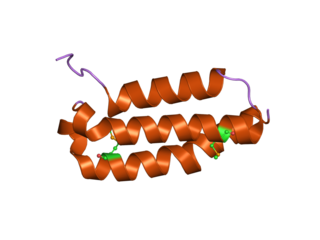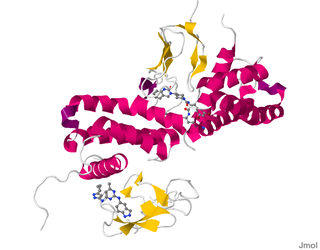
The dopamine transporter is a membrane-spanning protein coded for in the human by the SLC6A3 gene, that pumps the neurotransmitter dopamine out of the synaptic cleft back into cytosol. In the cytosol, other transporters sequester the dopamine into vesicles for storage and later release. Dopamine reuptake via DAT provides the primary mechanism through which dopamine is cleared from synapses, although there may be an exception in the prefrontal cortex, where evidence points to a possibly larger role of the norepinephrine transporter.
In biochemistry, an orphan receptor is a protein that has a similar structure to other identified receptors but whose endogenous ligand has not yet been identified. If a ligand for an orphan receptor is later discovered, the receptor is referred to as an "adopted orphan". Conversely, the term orphan ligand refers to a biological ligand whose cognate receptor has not yet been identified.

Calcitonin gene-related peptide (CGRP) is a member of the calcitonin family of peptides consisting of calcitonin, amylin, adrenomedullin, adrenomedullin 2 (intermedin) and calcitonin‑receptor‑stimulating peptide. Calcitonin is mainly produced by thyroid C cells whilst CGRP is secreted and stored in the nervous system. This peptide, in humans, exists in two forms: CGRP alpha, and CGRP beta. α-CGRP is a 37-amino acid neuropeptide and is formed by alternative splicing of the calcitonin/CGRP gene located on chromosome 11. β-CGRP is less studied. In humans, β-CGRP differs from α-CGRP by three amino acids and is encoded in a separate, nearby gene. The CGRP family includes calcitonin (CT), adrenomedullin (AM), and amylin (AMY).
Trace amine-associated receptors (TAARs), sometimes referred to as trace amine receptors, are a class of G protein-coupled receptors that were discovered in 2001. TAAR1, the first of six functional human TAARs, has gained considerable interest in academic and proprietary pharmaceutical research due to its role as the endogenous receptor for the trace amines phenethylamine, tyramine, and tryptamine – metabolic derivatives of the amino acids phenylalanine, tyrosine and tryptophan, respectively – ephedrine, as well as the synthetic psychostimulants, amphetamine, methamphetamine and methylenedioxymethamphetamine. In 2004, it was shown that mammalian TAAR1 is also a receptor for thyronamines, decarboxylated and deiodinated relatives of thyroid hormones. TAAR2–TAAR9 function as olfactory receptors for volatile amine odorants in vertebrates.

The calcitonin receptor (CT) is a G protein-coupled receptor that binds the peptide hormone calcitonin and is involved in maintenance of calcium homeostasis, particularly with respect to bone formation and metabolism.

Adrenomedullin is a vasodilator peptide hormone of uncertain significance in human health and disease. It was initially isolated in 1993 from a pheochromocytoma, a tumor of the adrenal medulla: hence the name.

The C5a receptor also known as complement component 5a receptor 1 (C5AR1) or CD88 is a G protein-coupled receptor for C5a. It functions as a complement receptor. C5a receptor 1 modulates inflammatory responses, obesity, development and cancers. From a signaling transduction perspective, C5a receptor 1 activation is implicated in β-arrestin2 recruitment via Rab5a, coupling of Gαi proteins, ERK1/2 phosphorylation, calcium mobilization and Rho activation leading to downstream functions, such as secretion of cytokines, chemotaxis, and phagocytosis.

Receptor activity modifying protein 1 is a protein that in humans is encoded by the RAMP1 gene.

Receptor activity modifying protein 2, also known as RAMP2, is a protein which in humans is encoded by the RAMP2 gene.

Receptor activity modifying protein 3, also known as RAMP3, is a human gene.

Transient receptor potential cation channel subfamily M member 5 (TRPM5), also known as long transient receptor potential channel 5 is a protein that in humans is encoded by the TRPM5 gene.

Calcitonin receptor-like (CALCRL), also known as the calcitonin receptor-like receptor (CRLR), is a human protein; it is a receptor for calcitonin gene-related peptide.

P2X purinoceptor 1, also ATP receptor, is a protein that in humans is encoded by the P2RX1 gene.

Vasoactive intestinal peptide receptor 2 also known as VPAC2, is a G-protein coupled receptor that in humans is encoded by the VIPR2 gene.

Hydroxycarboxylic acid receptor 3 (HCA3), also known as niacin receptor 2 (NIACR2) and GPR109B, is a protein which in humans is encoded by the HCAR3 gene. HCA3, like the other hydroxycarboxylic acid receptors HCA1 and HCA2, is a Gi/o-coupled G protein-coupled receptor (GPCR). The primary endogenous agonists of HCA3 are 3-hydroxyoctanoic acid and kynurenic acid. HCA3 is also a low-affinity biomolecular target for niacin (aka nicotinic acid).

Gamma-aminobutyric acid (GABA) B receptor, 2 (GABAB2) is a G-protein coupled receptor subunit encoded by the GABBR2 gene in humans.

DNA-directed RNA polymerase III subunit RPC9 is an enzyme that in humans is encoded by the CRCP gene.

ADM2 is a protein that in humans is encoded by the ADM2 gene.

GPR182 is a human gene which is an orphan G-protein coupled receptor.
Deborah Lucy Hay is a New Zealand academic. In 2022, she was elected a Fellow of the Royal Society Te Apārangi.










